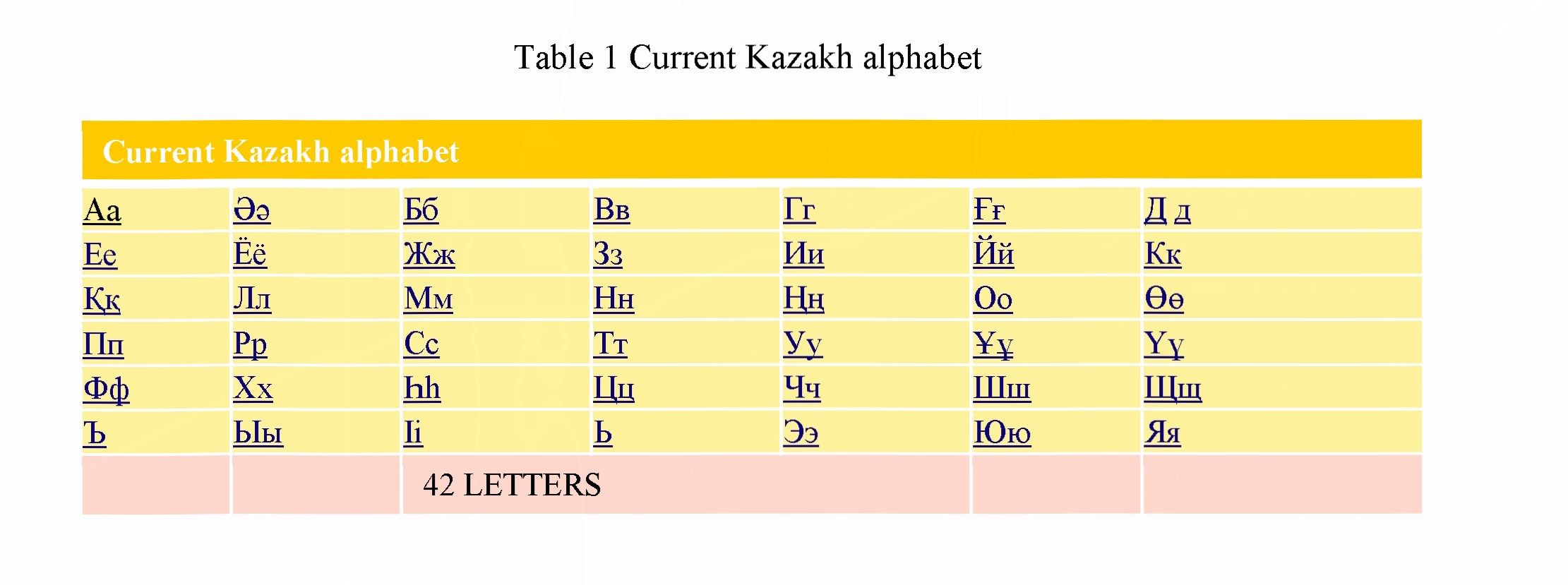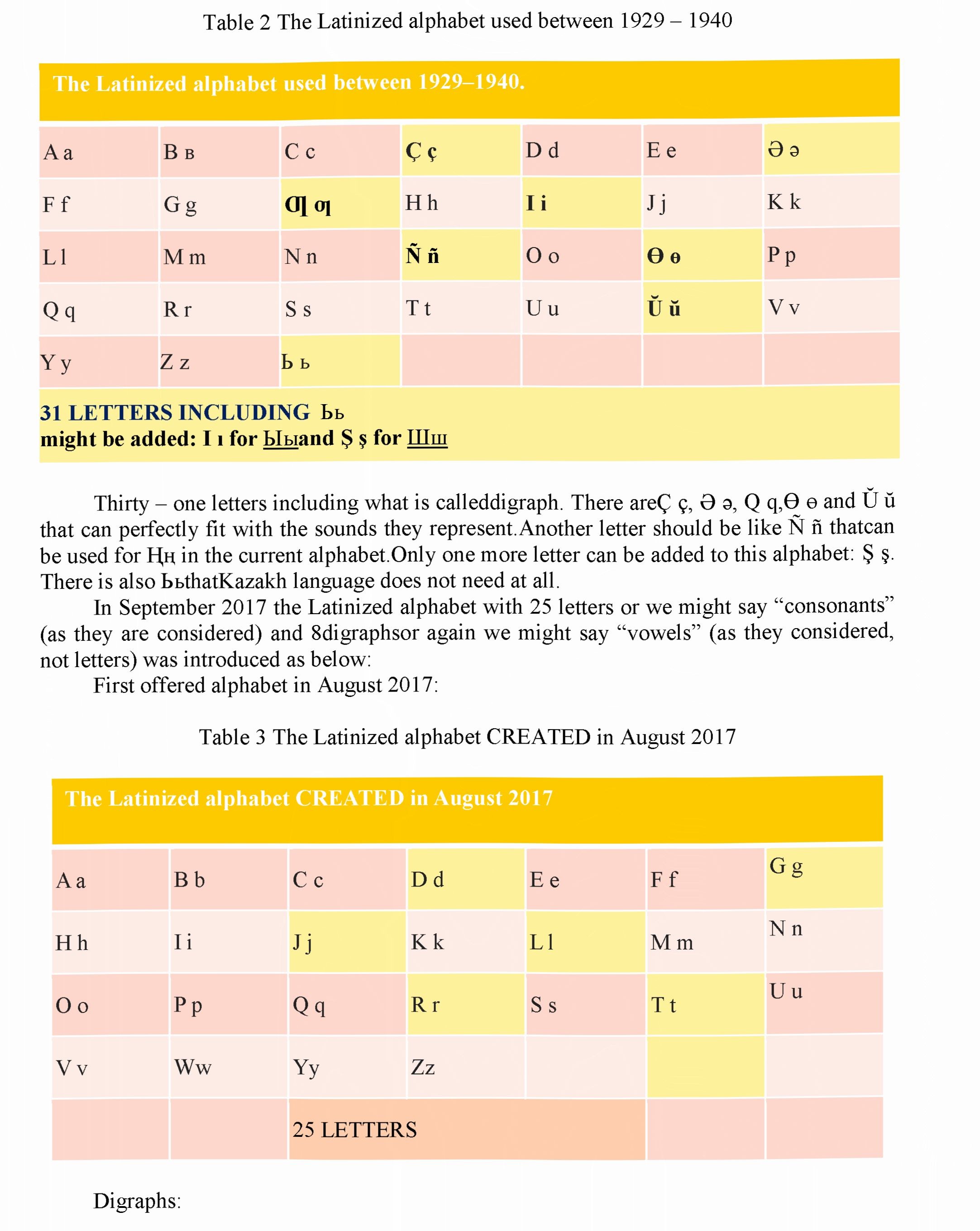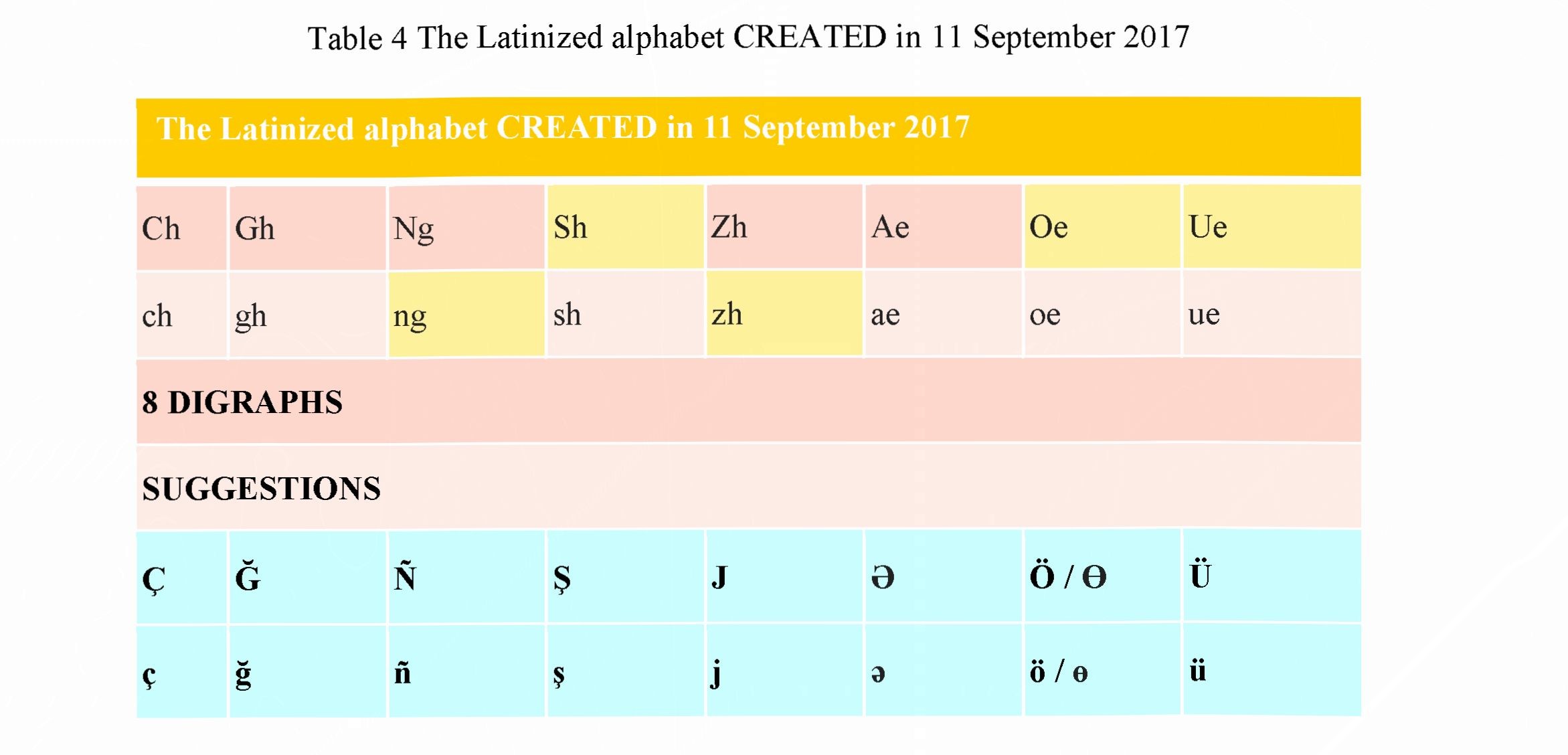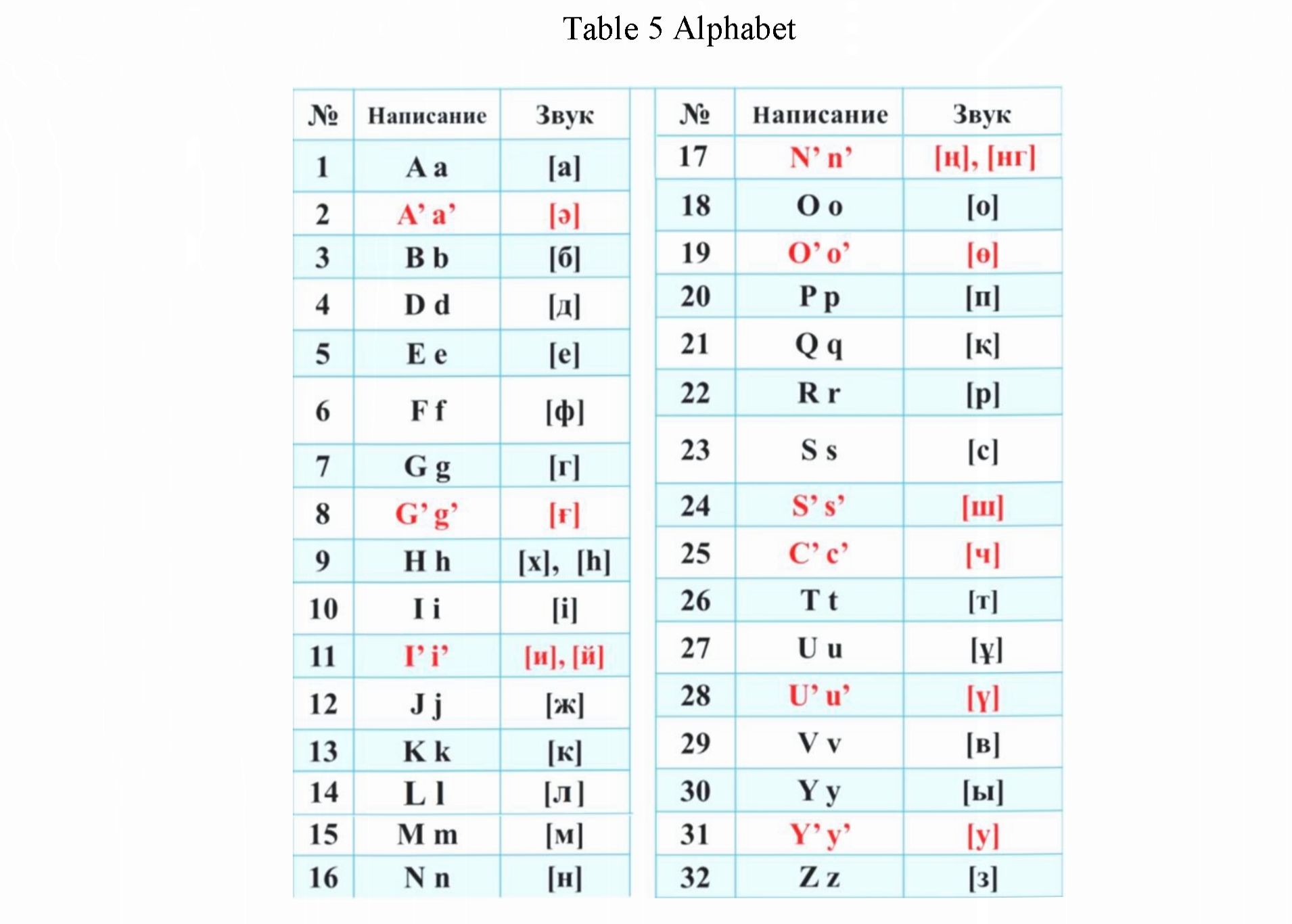Annotation
The new alphabet for the Kazakh language has been on the agenda of President Nursultan A. Nazarbayev since the collapse of the Soviet Union. After a quarter of a centuiy with independence in hand Nazarbayev again heated the discussion and gave details in his article published in the journal Egemen Kazakhstan on April 12, 2017. This essay discusses the matter of new alphabet from “national identity” point of view. Some teaching aspects are also discussed.
Recent Developments. Nowadays in Kazakhstan, a very hot discussion goes around the formulation and acceptance of a new Latinized alphabet for Kazakh language. It has been a delicate issue since the Republic gained its independence because of diminishes of the Soviets. When it comes to alphabet one has to deal with the language situation in this case it is Kazakh language. Though some theorists do not see the native language as only binding force among citizens of the country, it is one of the leading components in nation building process. Nursultan A. Nazarbayev, President of Kazakhstan Republic, announced his third plan in this process on April 12, 2017. He clearly stated his aim that was to complete the nation - building process.
Recent theorists of nationalism consider mother tongue although “... language is by no means the only binding force in modern societies” [1] as one of the main pillars of nation - building process. It has been the case in Kazakhstan in the process of newly state building after the collapse of the Soviet Union, as it was during the emergence of Modem Turkey in the 1920 s stated in the article [2]. One of many researchers on the matter of language in Kazakhstan states and describes the importance of Kazakh language as “the living air” that the Kazakhs breathe. This statement clearly indicates that the native language is as important as the fresh air to keep alive [3]. In fact the awareness of own language began earlier than the declaration of independence it is a very slow process to build a nation, depending on a local language.
Besides the importance of a native language, it is also important to have an alphabet suitable for mother language. The alphabet issue has been the case throughout the Turkic speaking world ranging from East Turkestan to the Balkans where all people with the Turkic origin live. These people have used many different alphabets throughout the history such as Orkhun scripts, Uighur, Arabic, Latinized and finally Cyrillic alphabets to mention some. Using or even choosing alphabet has many different reasons and philosophy or logic behind.
The representatives of Turkic speaking world mostly linguist and scientists met in Baku in 1926. Commonly taken decision was to switch all together to Latinized alphabet common to people with Turkic origin. The reason behind this mainly was to cut ties with Arabic world and its culture at the edge of new and modem emergence of Turkic republics. Another reason was to adapt easily to modern world with widely used Latinized alphabet. The Bolsheviks also supported this new attempt because they also wanted to cut the ties with the Tsarist Russia due to foundation of Soviet Union. It was and it is still reasonable. Within the Soviet Union, only Turkic speaking republics switched to Latinized alphabet and used it until the end of 1930s. It lasted no longer than ten years.
Since the independence because of the collapse of the Union, it has been a quarter of a century. During this period, there have been changes in terms of official status of Kazakh language and of curriculum at the schools. After all other changes the President of the Republic OfKazakhstan Nursultan Abishuli Nazarbayev declared that it is time to switch to Latinized new alphabet for Kazakhstan and Kazakh language. Of course, “there is logic behind it,” he says in his article published in the journal of Egemeti Kazakhstan on April 12, 2017. According to him, the logic behind this change is to catch up with a modem world and adopt easily with the scientific developments. However, in his article he entitles it as “Looking towards future: Spiritual renovation” but it seems more likely “national awakening.” He details it sampling from the far past and gives out the codes of cultural or national identity. In the process of nation building or national identity building is the matter of holding on to these codes and is to keep them forever.
What does the alphabet change have to do with all these steps? Itplays the key role. It cuts the ties with the system, logic, mentality, and the last but not the least psychology of the Soviet Union and the Russian language, and beyond.
As mentioned earlier though “language is not the only binding force in modem societies” it is important component in the formation of a nation.
Existence of a Distinct Kazak Language.
Even before the 1917 Revolution, Kazak intellectuals remained preoccupied with creating and preserving the language legacy through which they could stay close to their roots. The efforts of intellectuals to promote the use of the Kazak language could only mean that language is a means to assert their national identity.
The article titled as “Orinbor. 10 Fevral” and signed by Turk-balasi (Turkish son) aims at the important role of a language in the process of identity building. He says “for a nation to live up or disappear depends on a language. If a nation loses its language, it is also bound to disappear. If we are to become a Kazak nation we had better think about our own language not to feed ourselves.” [4]. This is only one example from 19th century. In addition, today in his article “ruhanijangary” or “spiritual awakening” the President Nazarbayev rightly mentions the roots of his mother and nation’s language Kazakh. He is not a linguist but he is very much self - conscious citizen OfKazakhstan. He follows the roots of his mother tongue
Kazakh language and new alphabets role in national identity building process
to 8th century Orhun Inscriptions, and then mentions other roots according to the centuries. This fact indicates that Kazakh language has its roots back in history with other Turkic languages.
Ahmet Buran and ErcanAlkaya well - known academicians from Turkey point out that “the Turkic people have used many different alphabets throughout history” and to follow up they say that “there is no other language written in many different alphabets as Turkic language” in their yet published article titled "Turklerdealfabeveyazi (Alphabet and script in Turks)According to same article some of the alphabets used by the Turkic people were Kokturk, Mani, Sogdian, Uyghur, Brahmi, Tibet, Armenian, Grek, Suryani, Arabic, Hebrew (Ibrani), Latin, and Cyrillic in 1300 years.
The question arises from this statement: “Why did the Turkic people use 13 (thirteen) different alphabets and still using different alphabets?” It is obvious that it has to do with geographical, social, and political reasons. Any nation or people establish ties with neighbors and exchanges social and cultural aspects. It their culture or civilization is stronger than neighbors they can influence, if not they can be influenced. The Turkic people also went through different geographical, social, cultural and of course political atmospheres. They changed their beliefs from Goktanri to Islam and in between many other belief systems including Buddhism and Shamanism. Therefore, they adapted different alphabets to their language. Language never changed though strong interaction existed.
In case of Kazakh language one could only talk about Arabic, Latinized, and Cyrillic based alphabets. Kazakh people Arabic alphabet used until 1929, then Latinized alphabet for ten or eleven years, and since 1940 they have been using Cyrillic based alphabet. Now as time requirement, Kazakhstan is moving to newly forged and Latinized alphabet. President Nazarbayev calls it as “it is necessary” and says, “there is a logic behind it” in his article.
Since Nazarbayev declared his article and mentioned the switch to Latinized alphabet there have been two kinds of scripts prepared and shared publicly. The first one prepared by a group oflinguists.
In the Wikipedia there is a definition striking me is the following in Kazakh language. I would like to share with you: «Қазақ әліпбиі - қазақ тілінің әріптерінің жүйелі тізбегі, қазақ халқының мәдени өмірінде басқ ада түркі халықтарымен бірге пайдаланып келген әр түрлі әріп таңбаларынан тұратын дыбыстық жазу жүйесі».
It says that Kazak alphabet is the systematic list of letters, within the civil life of Kazak people have been using with writing system of all kind of letters shared with and other Turkic people. So, alphabet which Kazak people use is also shared with other Turkic people. Current Kazakh alphabet [5]. The Latinized alphabet used between 1929 - 1940 [6].


The latest alphabet project seems better than this one, but it also has peculiarities [7]. At first glance it seems to avoid what is called “digraphs” but does not at all. It has aphostroph added right after some letters making them sound different. It is better to take a look at them.



Table 6 The Latinized alphabet CREATED in 09 October 2017
This is the latest Stuation in Kazakhstan concerning recent alphabet change. To sum up the presentation we can say that “Good but not enough.” It is good because the public opion in Kazakhstan came to the extent that the necessity of alphabet chance has been out of question. That might be considered as the first step towards “spiritual awakening.” The discussions evolved into second state that which concerned to which alphabet Kazakhstan will switch to. President Nazarbayev signed the second alphabet project with aphostoroph. All governmental institutions are rushing to organize meetings to support the new alphabet. Akimat or Government in the North Kazakhstan Region has Orginized number of meeting towards latinized alphabet. The North Kazakhstan State University in the name of M. Kozybayev also orginized scientific conferences and also students’ fair supporting the new alphabet.
Teaching the new alphabet.
From pedagogical point of view, one has to worry about teaching this new alphabet. The question arose during the discussion about wheather or not the country should switch to the Latinized alphabet. Kazakh people mainly parents who have kids going schools asked the question that how this new alphabet is going to be taught to kids. Would it not be difficult for kids to learn? The answer is “Yes.” Of course, it is a new and completely different form of writing system and it will be painful to teach kids at first glance. However, President
Nazarbayev points out that kids already learn English language beginning at their early ages. That means that they are already acquiented with this alphabet. Though he is not professional educator or pedagog, he has tremendous amount of experience. He went to Kazakh school and learned Kazakh at first then Russian. He believes that Latinized alphabet form will have an effect on the usage of his mother language Kazakh in a positive way. During the first years of independence he cleared the doubts about difficulties for those who got their education in Kazakh schools. As it is mentioned in an unpublished dissertation President Nursultan Nazarbaev noted, "if Kazak children do not get educated in Russian, they will not be able to enter the graduate schools. This is wrong," says Mr. Nazarbaev and adds:
It is easy to give many examples to prove those who believe the idea described above, wrong. For instance, I myself finished school in Kazak. I learned Russian, too. Now I can speak both languages [8].
Again going back to the early years Ofindependence and looking at the data revealed by the Ministry ofPublic Education of Kazakstan, it shows that out of two million four hundred thousand students who go to Russian language schools, more than a million are native Kazaks. On one hand, four hundred thousand out of two million students go to Russian schools. On the other hand, the number of Kazak students who go to Kazak schools is a bit more than nine hundred thousand. On the regional level, for example, in Qostanai oblast, about twenty percent of sixty - one thousand children at the school age get their education in Kazak. In Kokshetau, only a little more than thirty - two thousand students out of seventy - six thousand who go to Russian schools, are natives. And, only six thousand eight hundred students study in their mother tongue. It should be compared with the current situation and see the changes in this matter because at that time this situation worried the Kazak writers. This is because forthe Kazaks, language is very closely related to history andcivilization which form their cultural or ethnic identity, andtheir worry is described in the words of a Kazak intellectual:
As a consequence, a group of Kazak youngsters who do not know much about their mother tongue are unaware of the history and culture of the people to whom they belong, and neglect of the mother tongue with which they are bom, is growing greater [9].
The President is not alone in recognizing the problem for Kazak or the weakness of Kazak. The head of the department forthe Kazak schools, which was established in March 1989 withinthe Ministry ofPublic Education, stated:
...the only reason for the decline in the number of Kazak schools is the decrease in the use of the Kazak language... On official documents, in business, courts, and other public services, Kazak stopped being used. In short, the work of a person who completed his works in Kazak, is never completed...
President Nursultan Abishuli Nazarbayev attended the Kumltay of the World Kazaks in Almati and delivered a speech in which he slightly touched upon language issue but not the alphabet. However, the way that the latest language law describes the requirements to become a president is very important to keep in mind. To become a president for Kazakhstan one should have been born in Kazakhstan, no less than thirty - five years - old, ought to have lived no less than fifteen years in Kazakhstan, and the most importantly be able to speak the State language freely [10].
To sum up this short discussion about Kazakh language and new alphabet, one has to say that these two go side by side. It is obvious that Nazarbayev wants to seperate his mother language Kazakh from Russian. The new alphabet will help him achieve his goal. From one perspective, this could be his ultimate goal in building a nation; Kazakh nation in Kazakhstan living along with other ethnic groups in peace.
On one hand, this move by President Nazarbayev is a giant step towards “spiritual seperation” from Cyrillic alphabet. This will lead to more usage of Kazakh language. Through alphabet and language Kazakh people will end up using Kazakh language, thinking Kazakh way, and restoring Kazakh mentality in term of culture, history, and traditions. Last but defmetely not least to say that this new alphabet strategy will lead Kazakhstan to full independence in addition to economic and political independence since 1991.
References:
- Anthony D. Smith. Theories OfNationalism. (London: The GreshamPress, 2nd ed., 1983), p. 145.
- Didem Mersin Alici. “The role of culture, history and language in Turkish national identity building: an overemphasis on Central Asian roots,” Central Asian Survey, 1996, 15 (2), p. 227.
- V. Lakshin, "Ofhome and the world," The Soviet Multinational State: Readings and Documents, ed. by MarthaB. Olcott. (NewYork: M. E. Sharpe, Inc. 1990.) pp. 310 - 321.
- Articles by Qurmanbayev and Turk - balasi were cited in Amantai Sherip. Qazaq Poeziyasi Jane Ulttik Ideya. Almati: Bilim, 2000. p. 198.
- «Қазақ onin6ni»https://kk.wikipedia.org/wiki/%D2%9A%D0%B0%D0%B7%D0%B0%D2% 9B_%D3%99%D0%BB%Dl%96%D0%BF%D0%Bl%D0%B8%Dl%96 (19.09.2017).
- “Казахская письменность» https://ru.wikipedia.org/wiki/%D0%9A%D0%B0%D0%B7 %D0%B0%Dl%85%D 1%81%DO%B A%D0%B0%D 1%8F_%DO%BF%DO%B8%D 1%81%D 1%8C %D0%BC%D0%B5%D0%BD%D0%BD%D0%BE%Dl%81%Dl%82%Dl%8C (19.10.2017).
- “Назарбаеву показали новый проект казахского an(J)aBHTa”https://tengrinews.kz/kazakhstan_news/nazarbaevu - pokazali - novyiy - proekt - kazahskogo - alfavita- 328261/ (07.11.2017).
- Orhan Soylemez. Preserving Kazakh Cultural Identity after 1980. Columbia University, unpublished dissertation. 1995, s. 69 - 70. New York, USA.
- Qorghanbek Amanjolov. “Ana tili degende,” Juldiz, August 8, 1989. p. 162.
- (Article 42/2) cited in Bilgehan Atsiz Gdkdag, “Kazakistan Cumhuriyetinin dil siyasetine sosyo- Iinguistik bir yaklasim” v. 19, Tiirkler. Ankara: Yeni Tiirkiye Yayinlan, 2003. p. 415.